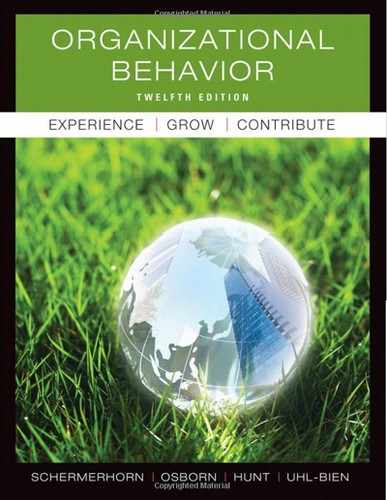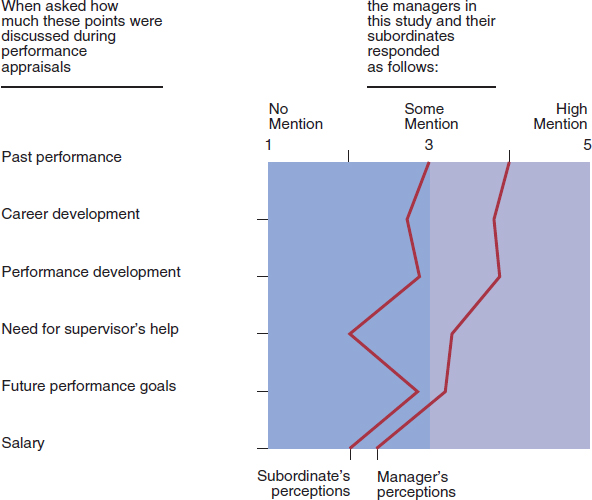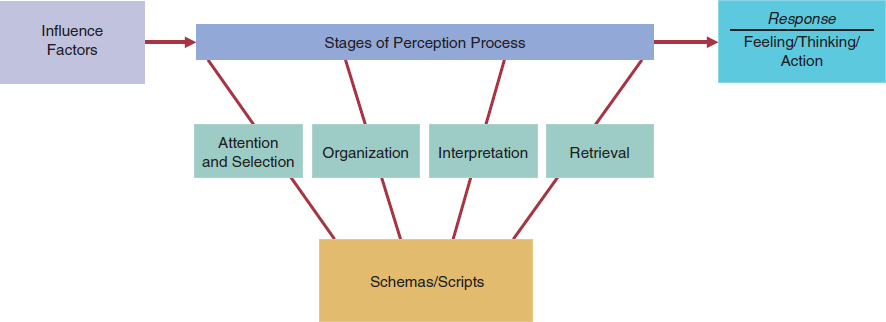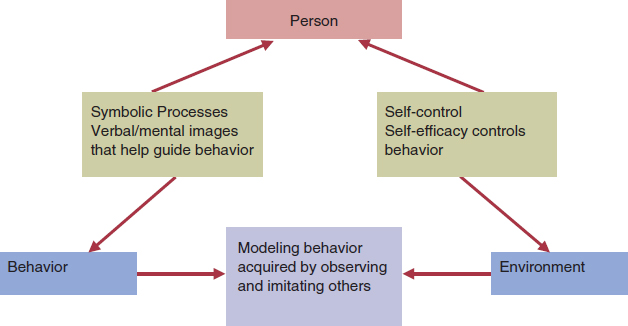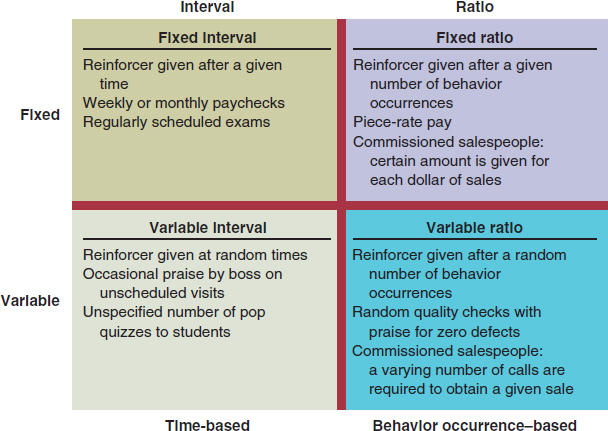Just-in-time Learning Saves the Day
Right about now, you're starting to panic. Your boss has a request: The Web designer is on maternity leave. You're good with computers, so can you edit some pages on the company's Web site?
What do you do? Cross your fingers and dive in head first. That's the spirit behind Head First Labs, a series of irreverent tech tutorial books designed to help readers learn–and remember–new and complicated information by incorporating storytelling, unexpected images, and hands-on projects.
Published by O'Reilly Media, the books emphasize just-in-time learning, the idea of acquiring just enough knowledge to get by, where and when you need it.
Here's the core of Head First's philosophy: Sometimes you have to trick your brain. Because its primary goal is to keep you safe and out of trouble, your gray matter tends to favor the important stuff (Danger! Fire! Angry boss!) over what it thinks is trivial. The solution: Couple the information you need now with enough unusual images, piquant captions, and unexpected elements to kick those neurons into learning mode.
“When you learn just-in-time, you're highly motivated,” says research statistician John Cook. Because you're already under the gun, “there's no need to imagine whether you might apply what you're learning.”a
But what about those Web pages the boss asked you to edit? With the help of a Head First guide, you learn just enough to make the necessary changes without crashing the site. Your grateful boss rewards you with your favorite kind of positive reinforcement: lunch on the company's dime. While you're waiting for the check, she leans in and asks, “How much do you know about databases?”
“What you know is trivial. The real issue is, what do you know how to do?”
–Roger Schank, Director of Northwestern University's Institute for Learning Sciencesb

Quick Summary
- O'Reilly Media's Head First books provide engaging just-in-time training on dense tech topics like programming and Web design.
- The guides use unexpected pictures, real-life examples, and hands-on exercises to increase information retention.
- Companies find that just-in-time learning tools cuts training costs, minimizes employee downtime, and improves productivity.
FYI: For employees with less than 12 years of work experience, trained (on the job) workers enjoy wages that are almost 10% higher than wages of untrained workers.
it's in the eye of the beholder
4 Perception, Attribution, and Learning
the key point
In all the events and experiences of everyday living it can be a shock when people view the same thing and come to different conclusions. But this is reality–people often perceive situations in different ways. The better we understand perception and attribution and their effects on how people behave and learn, the better we can be at dealing with events, people, and relationships not only just-in-time, but also in positive ways.
chapter at a glance
What Is Perception and Why Is It Important?
What Are the Common Perceptual Distortions?
What Is the Link Between Perception, Attribution, and Social Learning?
What Is Involved in Learning by Reinforcement?
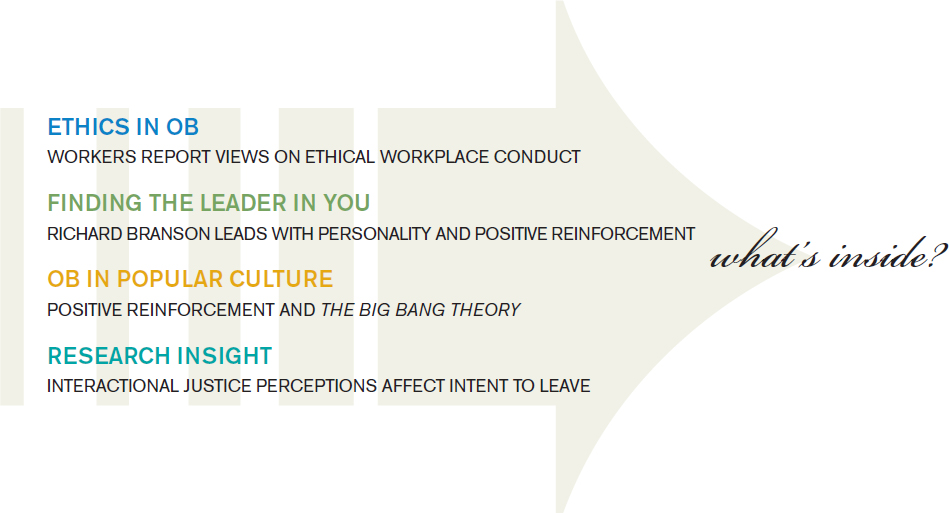
The Perception Process
LEARNING ROADMAP Factors Influencing Perception / Information Processing and the Perception Process / Perception, Impression Management, and Social Media
Perception is the process by which people select, organize, interpret, retrieve, and respond to information from the world around them.1 It is a way of forming impressions about ourselves, other people, and daily life experiences. It also serves as a screen or filter through which information passes before it has an effect on people. Because perceptions are influenced by many factors, different people may perceive the same situation quite differently. And since people behave according to their perceptions, the consequences of these differences can be great in terms of what happens next.
• perception is the process through which people receive and interpret information from the environment.
Consider the example shown in Figure 4.1. It shows substantial differences in how a performance appraisal discussion is perceived by managers and their subordinates. These managers may end up not giving much attention to things like career development, performance goals, and supervisory support since they perceive these issues were adequately addressed at performance appraisal time. But the subordinates may end up frustrated and unsatisfied because they perceive less attention was given and they want more.
Factors Influencing Perception
We can think of perception as a bubble that surrounds us and influences significantly the way we receive, interpret, and process information received from our environments. The many factors influencing perception include characteristics of the perceiver, the setting, and the perceived.
Figure 4.1 Contrasting perceptions between managers and subordinates regarding performance appraisal interviews.
The Perceiver A person's past experiences, needs or motives, personality, values, and attitudes may all influence the perceptual process. Someone with a strong achievement need tends to perceive a situation in terms of that need. If doing well in class is perceived as a way to help meet your achievement need, for example, you will tend to emphasize that aspect when choosing classes to take. In the same way, a person with a negative attitude toward younger workers may react antagonistically when asked to work for a young, newly hired team leader regardless of his or her competency.
The Setting The physical, social, and organizational context can influence the perception process. When Kim Jeffrey was promoted to CEO of Nestle Waters North America, he was perceived by subordinates as a frightening figure because he gave in to his temper and had occasional confrontations with them. Before the promotion Jeffrey's flare-ups had been tolerable, but in this new role as CEO they caused intimidation. The problem was resolved after he received feedback, learned of his subordinates' perceptions, and changed his manner and ways.2
The Perceived Characteristics of the perceived person, object, or event are also important in the perception process. We talk about them in terms of contrast, intensity, figure–ground separation, size, motion, and repetition or novelty. In respect to contrast for example, one Mac computer among six Hips or one man among six women will be perceived differently than one of six Mac computers or one of six men. The latter cases have less contrast.
Intensity varies in terms of brightness, color, depth, and sound of what is being perceived. A bright red sports car stands out from a group of gray sedans; whispering or shouting stands out from ordinary conversation. This links with a concept known as figure–ground separation. Look, for example, at the illustration in Figure 4.2. What do you see, faces or a vase? It depends on which image is perceived as the background and which as the figure or object of our attention.
In the matter of size, very small or very large people tend to be perceived differently and more readily than average-sized people. In terms of motion, moving objects are perceived differently than stationary objects. And, of course, repetition or frequency can also influence perceptions. Television advertisers well know that the more they put something in front of us the more likely we are to give it attention. Finally, the novelty of a situation affects its perception. A college student with streaks of hair dyed purple may be perceived quite differently by an instructor than others with a more common hair color.
Figure 4.2 Figure and ground illustration.
Figure 4.3 Information processing and the perception process.
Information Processing and the Perception Process
The various stages of the perception process are presented in Figure 4.3. They show that information processing during the perception process involves attention and selection, organization, interpretation, and retrieval.
Attention and Selection Our senses are constantly bombarded with so much information that if we don't screen it, we quickly become incapacitated with information overload. We tend to deal with this through selective screening that lets in only a tiny portion of all the information available.
• Selective screening allows only a portion of available information to enter our perceptions.
Some of the selective screening that we do comes from controlled processing—consciously deciding what information to pay attention to and what to ignore. Think, for example, about the last time you were at a noisy restaurant and screened out all the sounds but those of the person with whom you were talking. Some screening also takes place without conscious awareness. We often drive cars without thinking about the process; we're aware of things like traffic lights and other cars, but we don't pay conscious attention to them. This selectivity of attention and automatic information processing works well most of the time. But if a nonroutine event occurs, such as an animal darting onto the road, you may have an accident unless you quickly shift to controlled processing.
• Schemas are cognitive frameworks that represent organized knowledge developed through experience about people, objects, or events.
Organization Even though selective screening takes place in the attention stage, it's still necessary for us to organize information efficiently. This is done to some extent through schemas. These are cognitive frameworks that represent organized knowledge developed through experience about a concept or stimulus.3 We commonly use script schemas, person schemas, and person-in-situation schemas.
In the World Social Media It Pays to Take Charge of Your Script

Did you know that you already have an online brand? It's true. That's the person that you create as you profile yourself and interact with others in the world of social media. And it's a brand that endures. But does one brand do the job? Why not make sure the script fits the audience? Donna Byrd, publisher at The Root.com, uses Linked In and Twitter to voice expert opinions and publicize her company. “If you do it consistently,” she says, “you can become a trusted voice in your particular area of expertise.”
A script schema is a knowledge framework that describes the appropriate sequence of events in a given situation.4 For example, an experienced manager would use a script schema to think about the appropriate steps involved in running a meeting. A self schema contains information about a person's own appearance, behavior, and personality. For instance, people with decisiveness schemas tend to perceive themselves in terms of that aspect, especially in circumstances calling for leadership.
Person schemas refer to the way individuals sort others into categories, such as types or groups, in terms of similar perceived features. The terms prototype and stereotype are often used in this regard. They are abstract sets of features commonly associated with members of a category, such as a “good teammate” being intelligent, dependable, and hard-working. Once formed, they are stored in long-term memory and retrieved only when needed for a comparison of how well a person matches the schema's features. Person-in-situation schemas combine schemas built around persons (self and person schemas) and events (script schemas).5
Interpretation Once your attention has been drawn to certain stimuli and you have grouped or organized this information, the next step is to uncover the reasons behind the actions. Even if your attention is called to the same information and you organize it in the same way your friend does, you may still interpret it differently or make different assumptions about what you have perceived. As a team leader, for example, you might interpret compliments from a team member as due to his being an eager worker; your friend might interpret the behavior as insincere flattery.
Retrieval Each stage of the perception process becomes part of memory. This information stored in our memory must be retrieved if it is to be used. But all of us at times have trouble retrieving stored information. And memory decays, so that only some of the information may be retrieved. Schemas can make it difficult for people to remember things not included in them. If holding the prototype of a “good worker” as someone showing lots of effort, punctuality, intelligence, articulateness, and decisiveness, you may emphasize these traits and overlook others when evaluating the performance of a team member whom you generally consider good.
Perception, Impression Management, and Social Media
Richard Branson, CEO of the Virgin Group, is one of the richest and most famous executives in the world. He may also be the ultimate master of impression management, the systematic attempt to behave in ways that will create and maintain desired impressions in the eyes of others.6 One of Branson's early business accomplishments was the successful start-up of Virgin Airlines, now a global competitor to the legacy airlines. In a memoir, the former head of British Airways, Lord King, said: “If Richard Branson had worn a shirt and tie instead of a goatee and jumper, I would not have underestimated him.”7
• Impression management is the systematic attempt to infl uence how others perceive us.
Don't you wonder if creating a casual impression was part of Branson's business strategy? Whether intended or not, the chances are he's used this persona to very good advantage in other business dealings as well. It's an example of how much our impressions can count, both positive and negative, in how others perceive us. And it's not a new lesson; we've all heard it before. Who hasn't been told when heading off to a job interview—“Don't forget to make a good first impression”?
The fact is that we already practice a lot of impression management as a matter of routine in everyday life. Impression management is taking place when we dress, talk, act, and surround ourselves with things that reinforce a desirable self-image and help to convey that image to other persons. When well done, it can help us to advance in jobs and careers, form relationships with people we admire, and even create pathways to group memberships. We manage impressions by such activities as associating with the “right” people, “dressing up” and “dressing down” at the right times, making eye contact when introduced to someone, doing favors to gain approval, flattering others to impress them, taking credit for a favorable event and apologizing for a negative one, and agreeing with the opinions of others.8
One of the most powerful forces in impression management today might be the one least recognized—how we communicate our presence in the online world of social media. It might even be the case that this short message deserves to go viral: User beware! The brand you are building through social media may last a lifetime.
Brand Building and Impression Management in Social Networks

Don't let your social media presence get out of control. Impression management counts online as well as face-to-face, and here are some things to help you make it work for you.
- Ask: How do I want to be viewed? What are my goals in this forum?
- Ask: What am I communicating, or about to communicate, to my “public” audience?
- Ask: Before I post this item, is it something that I want my family, loved ones, or a potential employer to see? Do: Choose a respectable username.
- Do: Profile yourself only as you really would like to be known to others; keep everything consistent.
- Do: View your online persona as a “brand” that you are going to wear for a long time; make sure your persona and desired brand are a “fit” and not a “misfit.”
- Do: Post and participate in an online forum only in ways that meet your goals for your personal brand; don't do anything that might damage it.
It's no secret that more and more employers are intensely scouring the Web to learn what they can about job candidates. What they are gathering are impressions, ones left in the trails of the candidates' past social media journeys. One bad photo, one bad nickname, or one bad comment sends the wrong impression and can kill a great job opportunity. When active in the online world we are creating impressions of ourselves all the time. The problem is that they may be fun in social space but harmful in professional space.
There's a lot to learn about impression management and social media. At a minimum it pays to keep the two social media spaces—the social and the professional—separated with a good firewall in between them. Check the sidebar for more on this topic.
Common Perceptual Distortions
LEARNING ROADMAP Stereotypes / Halo Effects / Selective Perception / Projection / Contrast Effects / Self-Fulfilling Prophecies
Given the complexity of the information streaming toward us from the environments, we use various means of simplifying and organizing our perceptions. But these simplifications can cause inaccuracies in our impressions and in the perception process more generally. Common perceptual distortions trace to the use of stereotypes and prototypes, halo effects, selective perception, projection, contrast effects, and self-fulfilling prophecies.
Stereotypes
One of the most common simplifying devices in perception is the stereotype. It occurs when we identify someone with a group or category, and then use the attributes perceived to be associated with the group or category to describe the individual. Although this makes things easier for us by reducing the need to deal with unique individual characteristics, it is an oversimplification. Because stereotypes obscure individual differences, we can easily end up missing the real individual. For managers this means not accurately understanding the needs, preferences, and abilities of others in the workplace.
• A stereotype assigns attributes commonly associated with a group to an individual.
Some of the most common stereotypes, at work and in life in general, relate to such factors as gender, age, race, and physical ability. Why are so few top executives in industry African Americans or Hispanics? Legitimate questions can be asked about racial and ethnic stereotypes and about the slow progress of minority managers into America's corporate mainstream.9 Why is it that women constitute only a small percentage of American managers sent abroad to work on international business assignments? A Catalyst study of opportunities for women in global business points to gender stereotypes that place women at a disadvantage compared to men for these types of opportunities. The tendency is to assume women lack the ability and/or willingness to work abroad.10 Gender stereotypes may cause even everyday behavior to be misconstrued, for example: “He's talking with co-workers.” (Interpretation: He's discussing a new deal); “She's talking with co-workers.” (Interpretation: She's gossiping).11
Ability stereotypes and age stereotypes also exist in the workplace. Physically or mentally challenged candidates may be overlooked by a recruiter even though they possess skills that are perfect for the job. A talented older worker may not be promoted because a manager assumes older workers are cautious and tend to avoid risk.12 Yet a Conference Board survey of workers 50 and older reports that 72 percent felt they could take on additional responsibilities, and two-thirds were interested in further training and development.13 And then there's the flip side: Can a young person be a real leader, even a CEO? Facebook's founder and CEO Mark Zuckerberg is still in his 20s. And when current CEO Sheryl Sandberg was being recruited from Google she admits to this thought: “Wow, I'm going to work for a CEO who is quite young.” “Mark is a great leader,” she now says. After working for him, her perception has changed. “Mark has a real purity of vision … He brings people along with him.”14
RESEARCH INSIGHT

Interactional Justice Perceptions Affect Intent to Leave
Research reported by Merideth Ferguson, Neta Moye, and Ray Friedman links perceptions of interactional justice during recruitment interviews with effects on long-term employment relationships. Focusing on issues of fairness in the workplace, a substantial literature on organizational justice shows that people respond to perceived fair and unfair treatments in positive and negative ways, with the links between perceived injustice and negative behaviors being particularly strong.
This research examined fairness perceptions regarding negotiations taking place during the recruitment process and how these perceptions affected later intentions to leave. Two hypotheses were tested. First, it was hypothesized that perceived use of negotiation pressure by recruiters would have a negative impact on perceived interactional justice by job applicants. Second, it was hypothesized that perceived interactional injustice during recruiting negotiations would have a positive long-term impact on later intentions to leave by the newly hired employees.
Two studies were conducted. The first study asked a sample of 68 university alumni of a business program about their retrospective perceptions of interactional justice during job negotiations and their current intentions to leave. The second study asked a sample of recent MBA graduates to report perceptions of interactional justice during their job negotiations; they were asked six months later to report on their intentions to leave the new employer. Results from both studies offered confirmation for the two hypotheses.
In conclusion, Ferguson et al. state: “the sense of injustice one feels during a negotiation affects an employee's turnover intentions with the hiring organization … negotiations in the recruitment process can set the tone for the future employment relationship.” They recommend future research to examine how negotiating tactics like slow responses, dishonesty, disrespect, and lack of concessions influence justice perceptions and later intent to leave. They also suggest that perceived injustice in recruiting when jobs are plentiful may lead to applicants making alternative job choices, while such injustice when jobs are scarce may result in employees accepting the jobs but harboring intent to leave when the opportunity permits.

Do the Research What is your experience with interactional justice in the recruiting process? Can you design a study to gather the experiences of your cohorts, friends, and others on campus? How can your study pinpoint the impact of tactics such as setting a tight time limit on a job offer?
Source: Merideth Ferguson, Neta Moye, and Ray Friedman, “The Lingering Effects of the Recruitment Experience on the Long-Term Employment Relationship,” Negotiation and Conflict Management Research, Vol. 1 (2008), pp. 246-262. ''
Individual Differences Are Something to Be Celebrated

At Root Learning, a small management consulting firm in Sylvania, Ohio, and also ranked by the Wall Street Journal as one of America's Top Small Workplaces, the individual counts. Caricature drawings of each employee are prominently hung in the lobby with the goal of highlighting their interests and talents. CEO Jim Haudan sees this as a way of getting beyond stereotypes and making sure that everyone is viewed as a whole person. “If we pigeon-hole or just identify any of our people as a 'proofer' or an 'analyst,' it grossly limits what they're capable of,” he says.
Halo Effects
A halo effect occurs when one attribute of a person or situation is used to develop an overall impression of that individual or situation. Like stereotypes, these distortions are more likely to occur in the organization stage of perception. Halo effects are common in our everyday lives. When meeting a new person, for example, a pleasant smile can lead to a positive first impression of an overall “warm” and “honest” person. The result of a halo effect is the same as that associated with a stereotype, however, in that individual differences are obscured.
• A halo effect uses one attribute to develop an overall impression of a person or situation.
Halo effects are particularly important in the performance appraisal process because they can influence a manager's evaluations of subordinates' work performance. For example, people with good attendance records may be viewed as intelligent and responsible while those with poor attendance records are considered poor performers. Such conclusions may or may not be valid. It is the manager's job to try to get true impressions rather than allowing halo effects to result in biased and erroneous evaluations.
Selective Perception
Selective perception is the tendency to single out those aspects of a situation, person, or object that are consistent with one's needs, values, or attitudes. Its strongest impact occurs in the attention stage of the perceptual process. This perceptual distortion was identified in a classic research study involving executives in a manufacturing company.15 When asked to identify the key problem in a comprehensive business policy case, each executive selected a problem consistent with his or her functional area work assignments. Most marketing executives viewed the key problem area as sales, whereas production people tended to see the problem as one of production and organization. These differing viewpoints would likely affect how each executive would approach the problem; they might also create difficulties as the executives tried to work together to improve things.
• Selective perception is the tendency to define problems from one's own point of view.
Welcome to the Elsewhere class Where Stress Is a way of Life

The label Elsewhere Class is often used to describe hi-tech young professionals. “Elsewhere” is the place you are thinking about even though you are not there physically. Even if you aren't thinking about it, technology brings it to you. In this sense technology is an enabler of work preoccupation. You may be at home or out shopping, but you're thinking it's time to check work messages. Members of the Elsewhere Class face lots of stress in struggles to balance work, family, and leisure.
Projection
Projection is the assignment of one's personal attributes to other individuals. It is especially likely to occur in the interpretation stage of perception. A classic error is projecting your needs, values, and views onto others. This causes their individual differences to get lost. Such projection errors can be controlled through a high degree of self-awareness and empathy—the ability to view a situation as others see it.
• Projection assigns personal attributes to other individuals.
Suppose, for example, that you enjoy responsibility and achievement in your work. Suppose, too, that you are the newly appointed leader of a team whose jobs seem dull and routine. You may move quickly to expand these jobs so that members get increased satisfaction from more challenging tasks. Basically, you want them to experience things that you value in work. But this may not be a good decision. Instead of designing team members' jobs to best fit their needs, you have designed their jobs to best fit yours. They may be quite satisfied and productive doing jobs that seem dull and routine to you.
Contrast Effects
We mentioned earlier how a bright red sports car would stand out from a group of gray sedans. This shows a contrast effect in which the meaning or interpretation of something is arrived at by contrasting it with a recently occurring event or situation. This form of perceptual distortion can occur, say, when a person gives a talk following a strong speaker or is interviewed for a job following a series of mediocre applicants. A contrast effect occurs when an individual's characteristics are contrasted with those of others recently encountered who rank higher or lower on the same characteristics.
• A contrast effect occurs when the meaning of something that takes place is based on a contrast with another recent event or situation.
Self-Fulfilling Prophecies
A final perceptual distortion is the self-fulfilling prophecy—the tendency to create or find in another situation or individual that which you expected to find in the first place. A self-fulfilling prophecy is sometimes referred to as the “Pygmalion effect,” named for a mythical Greek sculptor who created a statue of his ideal mate and then made her come to life.16
• A self-fulfilling prophecy is creating or finding in a situation that which you expected to find in the first place.
Self-fulfilling prophecies can have both positive and negative outcomes. In effect, they may create in work and personal situations that which we expect to find. Suppose you assume that team members prefer to satisfy most of their needs outside the work setting and want only minimal involvement with their jobs. Consequently, you assign simple, highly structured tasks designed to require little involvement. Can you predict what response they will have to this situation? In fact, they may show the very same lack of commitment you assumed they would have in the first place. In this case your initial expectations get confirmed as a negative self-fulfilling prophecy.
ETHICS IN OB

WORKERS REPORT VIEWS ON ETHICAL WORKPLACE CONDUCT
These data on ethical workplace conduct are from a survey conducted for Deloitte & Touche USA.
- 42 percent of workers say the behavior of their managers is a major influence on an ethical workplace.
- Most common unethical acts by managers and supervisors include verbal, sexual, and racial harassment, misuse of company property, and giving preferential treatment.
- Most workers consider it unacceptable to steal from an employer, cheat on expense reports, take credit for another's accomplishments, and lie on time sheets.
- Most workers consider it acceptable to ask a work colleague for a personal favor, take sick days when not ill, and use company technology for personal affairs.
- Top reasons for unethical behavior are lack of personal integrity (80%) and lack of job satisfaction (60%).
- 91 percent of workers are more likely to behave ethically when they have work-life balance; 30 percent say they suffer from poor work-life balance.
Whose Ethics Count? Shouldn't an individual be accountable for her or his own ethical reasoning and analysis? How and why is it that the ethics practices of others, including managers, influence our ethics behaviors? What can be done to strengthen people's confidence in their own ethical frameworks so that even bad management won't result in unethical practices?
Self-fulfilling prophecies can also have a positive side. In a study of army tank crews, one set of tank commanders was told that some members of their assigned crews had exceptional abilities while others were only average. But, the crew members had been assigned randomly so that the two test groups were equal in ability. The commanders later reported that the so-called “exceptional” crew members performed better than the “average” ones. The study also revealed the commanders had given more attention and praise to the crew members for whom they had the higher expectations.17 Don't you wonder what might happen with students and workers in general if teachers and managers adopted more uniformly positive and optimistic approaches toward them?
Perception, Attribution, and Social Learning
LEARNING ROADMAP Importance of Attributions / Attribution Errors / Attribution and Social Learning
One of the ways in which perception exerts its influence on behavior is through Attribution is the attribution. This is the process of developing explanations or assigning per-process of creating ceiled causes for events. It is natural for people to try to explain what they explanations for events. observe and the things that happen to them. What happens when you perceive that someone in a job or student group isn't performing up to expectations? How do you explain this? And, depending on the explanation, what do you do to try and correct things?
• Attribution is the process of creating explanations for events.
Importance of Attributions
Attribution theory helps us understand how people perceive the causes of events, assess responsibility for outcomes, and evaluate the personal qualities of the people involved.18 It is especially concerned with whether the assumption is that an individual's behavior, such as poor performance, has been internally or externally caused. Internal causes are believed to be under an individual's control— you believe Jake's performance is poor because he is lazy. External causes are seen as coming from outside a person—you believe Kellie's performance is poor because the software she's using is out of date.
According to attribution theory, three factors influence this internal or external determination of causality: distinctiveness, consensus, and consistency. Distinctiveness considers how consistent a person's behavior is across different situations. If Jake's performance is typically low, regardless of the technology with which he is working, we tend to assign the poor performance to an internal attribution—there's something wrong with Jake. If the poor performance is unusual, we tend to assign an external cause to explain it—there's something happening in the work context.
Consensus takes into account how likely all those facing a similar situation are to respond in the same way. If all the people using the same technology as Jake perform poorly, we tend to assign his performance problem to an external attribution. If others do not perform poorly, we attribute Jake's poor performance to internal causation. Consistency concerns whether an individual responds the same way across time. If Jake performs poorly over a sustained period of time, we tend to give the poor performance an internal attribution. If his low performance is an isolated incident, we may well attribute it to an external cause.
Figure 4.4 Attribution error when explaining for poor performance.
Attribution Errors
Two perception errors are associated with the assignment of internal versus external causation—fundamental attribution error and self-serving bias.19 Look at the data reported in Figure 4.4. When managers were asked to identify, or attribute, causes of poor performance among their subordinates, they most often blamed internal deficiencies of the individual—lack of ability and effort, rather than external deficiencies in the situation—lack of support. This demonstrates fundamental attribution error—the tendency to underestimate the influence of situational factors and to overestimate the influence of personal factors when evaluating someone else's behavior. When asked to identify causes of their own poor performance, however, the managers mostly cited lack of support—an external, or situational, deficiency. This indicates self-serving bias—the tendency to deny personal responsibility for performance problems but to accept personal responsibility for performance success.
• Fundamental attribution error overestimates internal factors and underestimates external factors as influences on someone's behavior.
• Self-serving bias underestimates internal factors and overestimates external factors as influences on someone's behavior.
The managerial implications of attribution theory trace back to the fact that perceptions influence behavior.20 For example, a team leader who believes that members are not performing well and perceives the reason to be an internal lack of effort is likely to respond with attempts to “motivate” them to work harder. The possibility of changing external, situational factors that may remove job constraints and provide better organizational support may be largely ignored. This oversight could sacrifice major performance gains for the team.
Attribution and Social Learning
Perception and attribution are important components in social learning theory, which describes how learning takes place through the reciprocal interactions among people, behavior, and environment. According to the work of Albert Bandura, an individual uses modeling or vicarious learning to acquire behavior by observing and imitating others.21 In a work situation, the model may be a higher manager or co-worker who demonstrates desired behaviors. Mentors or senior workers who befriend younger and more inexperienced protégés can also be important models. Indeed, some have argued that a shortage of mentors for women Self-efficacy is a in senior management has been a major constraint to their progression up the person's belief that she or career ladder.22
• Social learning theory describes how learning occurs through interactions among people, behavior, and environment.
Figure 4.5 Simplified model of social learning.
The symbolic processes shown in Figure 4.5 are important in social learning. Words and symbols used by managers and others in the workplace help communicate values, beliefs, and goals and thus serve as guides to an individual's behavior. For example, a “thumbs up” or other signal from the boss lets you know your behavior is appropriate. At the same time, the person's self-control is important in influencing his or her own behavior. And self-efficacy—the person's belief that he or she can perform adequately in a situation—is an important part of such self-control. Closely associated with the concept of self-efficacy are such terms as confidence, competence, and ability.23
• Self-efficacy is a person's belief that she or he is capable of performing a task.
Four Ways to Build or Enhance Self-Efficacy

Scholars generally recognize the following four ways of building or enhancing our self-efficacy:
- Enactive mastery–gaining confidence through positive experience. The more you work at a task, so to speak, the more your experience builds and the more confident you become at doing it.
- Vicarious modeling–gaining confidence by observing others. When someone else is good at a task and we are able to observe how they do it, we gain confidence in being able to do it ourselves.
- Verbal persuasion–gaining confidence from someone telling us or encouraging us that we can perform the task. Hearing others praise our efforts and link those efforts with performance successes is often very motivational.
- Emotional arousal–gaining confidence when we are highly stimulated or energized to perform well in a situation. A good analogy for arousal is how athletes get “psyched up” and highly motivated to perform in key competitions.
People with high self-efficacy believe that they have the necessary abilities for a given job, that they are capable of the effort required, and that no outside events will hinder them from attaining their desired performance level.24 In contrast, people with low self-efficacy believe that no matter how hard they try, they cannot manage their environment well enough to be successful. If you feel high self-efficacy as a student, a low grade on one test is likely to encourage you to study harder, talk to the instructor, or do other things to enable you to do well the next time. In contrast, a person low in self-efficacy would probably drop the course or give up studying. Of course, even people who are high in self-efficacy do not control their environment entirely.
Learning by Reinforcement
LEARNING ROADMAP Operant Conditioning and the Law of Effect / Positive Reinforcement / Negative Reinforcement / Punishment / Extinction / Reinforcement Pros and Cons
When it comes to learning, the concept of reinforcement is very important in OB. It has a very specific meaning that has its origin in some classic studies in psychology.25 Reinforcement is the administration of a consequence as a result of a Reinforcement is the behavior. Managing reinforcement properly can change the direction, level, and delivery of a consequence persistence of an individual's behavior. To best understand this idea, it is helpful as a result of behavior. to review concepts of conditioning and reinforcement you may have already learned in a basic psychology course.
• Reinforcement is the delivery of a consequence as a result of behavior.
Operant Conditioning and the Law of Effect
Classical conditioning, studied by Ivan Pavlov, is a form of learning through association that involves the manipulation of stimuli to influence behavior. The Russian psychologist “taught” dogs to salivate at the sound of a bell by ringing the bell when feeding the dogs. The sight of the food naturally caused the dogs to salivate. The dogs “learned” to associate the bell ringing with the presentation of food and to salivate at the ringing of the bell alone. Such learning through association is so common in organizations that it is often ignored until it causes considerable confusion.
The key here is to understand stimulus and conditioned stimulus. A stimulus is something that incites action and draws forth a response, such as food for the dogs. The trick is to associate one neutral stimulus—the bell ringing, with another stimulus that already affects behavior—the food. The once-neutral stimulus is called a conditioned stimulus when it affects behavior in the same way as the initial stimulus. Take a look at Figure 4.6 for a work example. Here, the boss's smiling becomes a conditioned stimulus because of its linkage to his criticisms.
Figure 4.6 Differences between classical and operant conditioning approaches for a boss and subordinate.
An approach popularized by B. F. Skinner extends these reinforcement applications to include more than just stimulus and response behavior.26 It involves operant conditioning, the process of controlling behavior by manipulating its consequences. You may think of operant conditioning as learning by reinforcement. In a work setting the goal is to use reinforcement principles to systematically reinforce desirable behavior and discourage undesirable behavior.27
• Operant conditioning is the control of behavior by manipulating its consequences.
Operant conditioning calls for examining antecedents, behavior, and consequences. The antecedent is the condition leading up to or “cueing” behavior. Figure 4.6 gives the example of an agreement with the boss to work overtime as needed. If the employee actually does work overtime, this is the behavior. The consequence would be the boss's praise. In operant conditioning, this consequence strengthens the behavior and makes it more likely to reoccur when the antecedent next appears.
The basis for operant conditioning rests in E. L. Thorndike's law of effect.28 It is simple but powerful: Behavior that results in a pleasant outcome is likely to be repeated, whereas behavior that results in an unpleasant outcome is not likely to be repeated. The implications of this law are rather straightforward. If you want more of a behavior, you must make the consequences for the individual positive.
• The law of effect is that behavior followed by pleasant consequences is likely to be repeated; behavior followed by unpleasant consequences is not.
Extrinsic rewards, such as pay and praise, are positively valued work outcomes that are given to the individual by some other person. They become external reinforcers or environmental consequences that can substantially influence a person's work behaviors through the law of effect.29 As shown in Figure 4.7, some of these are contrived rewards that are planned, and have direct costs and budgetary implications. Examples are pay increases and cash bonuses. Others are natural rewards that have no cost other than the manager's personal time and efforts. Examples are verbal praise and recognition in the workplace.
• Extrinsic rewards are positively valued work outcomes that are given to the individual by some other person.
The use of extrinsic rewards to systematically reinforce desirable work behavior and to discourage unwanted work behavior is known as organizational behavior modification, or OB Mod for short. It involves the use of four basic reinforcement strategies: positive reinforcement, negative reinforcement (or avoidance), punishment, and extinction.30
• Organizational behavior modification is the use of extrinsic rewards to systematically reinforce desirable work behavior and discourage undesirable behavior.
Positive Reinforcement
B. F. Skinner and his followers advocate positive reinforcement—the administration of positive consequences that tend to increase the likelihood of repeating the desirable behavior in similar settings. For example, a team leader nods to a team member to express approval after she makes a useful comment during a sales meeting. This increases the likelihood of future useful comments from the team member, just as the leader would hope.
• Positive reinforcement strengthens a behavior by making a desirable consequence contingent on its occurrence.
Figure 4.7 A sample of contrived and natural extrinsic rewards that can be allocated by managers.
Finding the Leader in You
RICHARD BRANSON LEADS WITH PERSONALITY AND POSITIVE REINFORCEMENT
Sir Richard Branson, well-known founder of Virgin Group, is a believer in positive reinforcement. “For the people who work for you or with you, you must lavish praise on them at all times,” he says. “If a flower is watered, it flourishes. If not it shrivels up and dies.” And besides, he goes on to add: “It's much more fun looking for the best in people.”
Virgin Group is a business conglomerate employing many thousands of people around the globe. It even holds a space venture—Virgin Galactic. It's all very creative and ambitious—but that's Branson. “I love to learn things I know little about,” he says.

Yet if you bump into Branson on the street you might be surprised. He'scasual, he's smiling, and he's fun; he's also considered brilliant when it comesto business and leadership. His goal is to build Virgin into “the most respected brand in the world.”
As the man behind the Virgin brand, Branson is described as “flamboyant,” something that he doesn't deny and also considers a major business advantage that keeps him and his ventures in the public eye.
About leadership Branson says: “Having a personality of caring about people is important … You can't be a good leader unless you generally like people. That is how you bring out the best in them.” He claims his own style was shaped by his family and childhood. At age 10 his mother put him on a 300-mile bike ride to build character and endurance. At 16 he started a student magazine. By the age of 22 he was launching Virgin record stores. And by the time he was 30 Virgin Group was running at high speed.
As for himself, Branson says he'll probably never retire. Now known as Sir Richard after being knighted, he enjoys Virgin today “as a way of life.” But he also says that “In the next stage of my life I want to use our business skills to tackle social issues around the world … Malaria in Africa kills four million people a year. AIDS kills even more … I don't want to waste this fabulous situation in which I've found myself.”
What's the Lesson Here?
Sir Richard obviously has confidence in himself as both a person and a leader. How much of his business and leadership success comes from management of his public impression? Is this something we might all use to advantage? And when he says “you must lavish praise all the time” on the people who work for you, is he giving us an example of the law of effect in action? Finally, Branson seems to have moved beyond the quest for personal business success; he's now talking about real social impact. Is that a natural progression for successful entrepreneurs and business executives?
To begin using a strategy of positive reinforcement, we need to be aware that not all rewards end up being positive reinforcers. Recognition, for example, is both a reward and a potential positive reinforcer. But it becomes a positive reinforcer only if a person's performance later improves. Sometimes, a “reward” doesn't work as intended. For example, a team leader might praise a team member in front of others for finding errors in a report that the group had prepared. If the members then give their teammate the silent treatment, however, the worker is less likely to report such errors in the future. In this case, the “reward” fails to serve as a positive reinforcer of the desired work behavior.
To have maximum reinforcement value, a reward must be delivered only if the desired behavior is exhibited. That is, the reward must be contingent on the desired behavior. This principle is known as the law of contingent reinforcement. For example, a supervisor's praise should be contingent on the worker's doing something identifiably well, such as giving a constructive suggestion in a meeting. Also, the reward must be given as soon as possible after the desired behavior. This is known as the law of immediate reinforcement.31 If the supervisor waits for the annual performance review to praise a worker for providing constructive comments, the law of immediate reinforcement would be violated.
• The law of contingent reinforcement states a reward should only be given when the desired behavior occurs.
• The law of immediate reinforcement states a reward should be given as soon as possible after the desired behavior occurs.
Shaping The power of positive reinforcement can be mobilized through a process known as shaping. This is the creation of a new behavior by the positive reinforcement of successive approximations to it. For example, new machine operators in the Ford Motor casting operation in Ohio must learn a complex series of tasks in pouring molten metal into castings in order to avoid gaps, overfills, or cracks.32 The molds are filled in a three-step process, with each step progressively more difficult than its predecessor. Astute master crafts persons first show newcomers how to pour as the first step and give praise based on what they did right. As the apprentices gain experience, they are given praise only when all of the elements of the first step are completed successfully. Once the apprentices have mastered the first step, they move to the second. Reinforcement is given only when the entire first step and an aspect of the second step are completed successfully. Over time, apprentices learn all three steps and are given contingent positive rewards immediately upon completing a casting that has no cracks or gaps. In this way behavior is shaped gradually rather than changed all at once.
• Shaping is positive reinforcement of successive approximations to the desired behavior.
OB IN POPULAR CULTURE

POSITIVE REINFORCEMENT AND THE BIG BANG THEORY
Learning is an important part of an individual's development. In the workplace, reinforcement can be used to help employees learn proper behavior. Through the principle of operant conditioning, reinforcement uses consequences to help mold the behavior of others.
In one episode of “The Big Bang Theory” Leonard, Penny, and Sheldon are watching anime on television. Penny is bored with a show she does not understand and begins to tell a story about a high school classmate named Anna Mae. Sheldon uses chocolate to get her to stop talking. Later, when Penny's cell phone rings, Sheldon again uses chocolate to get Penny to take the call in the hallway. Leonard discovers the tactic and forbids Sheldon from experimenting with Penny. Sheldon then sprays Leonard with a water bottle (punishment).
The episode is hilarious yet serious. It demonstrates how easily behavior can be influenced through the proper application of operant conditioning techniques. However, it's important to remember that what works at one point in time may not work at another. If Sheldon continues to give Penny chocolates, for example, will she eventually lose her desire for them and the reinforcement will no longer be effective?
Get to Know Yourself Better Take a look at Experiential Exercise 12, The Downside of Punishment, in the OB Skills Workbook. The focus of the exercise is entirely on punishment. Why do you think this is the case? Have you ever experienced punishment as a student or an employee? What was your reaction? Have you ever seen a boss punish an employee in front of co-workers or customers? Is this an effective way to change behavior? If you were a teacher, how would you handle a behavior problem with a student–such as unwanted text messaging in class?
Scheduling Positive Reinforcement Positive reinforcement can be given on either continuous or intermittent schedules. Continuous reinforcement administers a reward each time a desired behavior occurs, whereas intermittent reinforcement rewards behavior only periodically. In general, continuous reinforcement draws forth a desired behavior more quickly than does intermittent reinforcement. But it is costly in the consumption of rewards, and the behavior is more easily extinguished when reinforcement is no longer present. Behavior acquired under intermittent reinforcement is more resistant to extinction and lasts longer upon the discontinuance of reinforcement. This is why shaping typically begins with a continuous reinforcement schedule and then gradually shifts to an intermittent one.
• Continuous reinforcement administers a reward each time a desired behavior occurs.
• Intermittent reinforcement rewards behavior only periodically.
As shown in Figure 4.8, intermittent reinforcement can be given according to fixed or variable schedules. Variable schedules typically result in more consistent patterns of desired behavior than do fixed reinforcement schedules. Fixed-interval schedules provide rewards at the first appearance of a behavior after a given time has elapsed. Fixed-ratio schedules result in a reward each time a certain number of the behaviors have occurred. A variable-interval schedule rewards behavior at random times, while a variable-ratio schedule rewards behavior after a random number of occurrences.
Figure 4.8 Alternative schedules of positive reinforcement.
Negative Reinforcement
A second reinforcement strategy used in operant conditioning is negative reinforcement or avoidance learning. It uses the withdrawal of negative consequences to increase the likelihood of desirable behavior being repeated. For example, the manager regularly nags a worker about being late for work and then doesn't nag when the worker next shows up on time. The term negative reinforcement comes from this withdrawal of the negative consequences. The strategy is also called avoidance learning because its intent is for the person to avoid the negative consequence by performing the desired behavior. Think of it this way. The streets may be deserted, but we still stop at a red light to avoid a traffic ticket.
• Negative reinforcement strengthens a behavior by making the avoidance of an undesirable consequence contingent on its occurrence.
Punishment
A third reinforcement strategy is punishment. Unlike positive reinforcement and negative reinforcement, it is intended not to encourage desired behavior but to discourage undesirable behavior. Formally defined, punishment is the administration of negative consequences or the withdrawal of positive consequences to reduce the likelihood of a behavior being repeated.
• Punishment discourages a behavior by making an unpleasant consequence contingent on its occurrence.
• Extinction discourages a behavior by making the removal of a desirable consequence contingent on its occurrence.
There is evidence that punishment administered for poor performance can lead to better performance without a significant effect on satisfaction. But punishment seen by workers as arbitrary and capricious leads to low satisfaction as well as low performance.33 The point here is that punishment can be handled poorly, or it can be handled well as suggested in the sidebar.
How to Make Positive Reinforcement and Punishment Work for You

Positive Reinforcement
- Clearly identify desired work behaviors.
- Maintain a diverse inventory of rewards.
- Inform everyone what must be done to get rewards.
- Recognize individual differences when allocating rewards.
- Follow the laws of immediate and contingent reinforcement.
Punishment
- Tell the person what is being done wrong.
- Tell the person what is being done right.
- Make sure the punishment matches the behavior.
- Administer the punishment in private.
- Follow the laws of immediate and contingent reinforcement.
It's also worth noting that punishment may be offset by positive reinforcement received from another source. Take the case of a worker being positively reinforced by peers at the same time that he is receiving punishment from the manager. Sometimes the positive value of peer support is so great that the individual chooses to put up with punishment and continues the bad behavior. As many times as a child may be verbally reprimanded by a teacher for playing jokes, for example, the “grins” offered by classmates may keep the jokes flowing in the future.
Extinction
The final reinforcement strategy is extinction— the withdrawal of reinforcing consequences in order to weaken undesirable behavior. For example, Enya is often late for work and co-workers provide positive reinforcement by covering for her. The manager instructs Enya's co-workers to stop covering, thus withdrawing the positive consequences of her tardiness. This is a use of extinction to try and get rid of an undesirable behavior. But even though a successful extinction strategy decreases the frequency of or weakens behavior, the behavior is not “unlearned.” It simply is not exhibited and will reappear if reinforced again.
Reinforcement Pros and Cons
The effective use of the four reinforcement strategies can help manage human behavior at work. Testimony to this effect is found in the wide application of these strategies in all sorts of work settings, and by the number of consulting firms that specialize in reinforcement techniques. But use of these approaches is not without criticism.
Some critics claim that the success of specific reinforcement programs involves isolated cases that have been analyzed without the benefit of scientific research designs. This makes it hard to conclude definitively whether the observed results were really caused by reinforcement dynamics. One critic goes so far as to argue that any improved performance may well have occurred only because of the goal setting involved—that is, because specific performance goals were clarified, and workers were individually held accountable for their accomplishment.34 Another major criticism rests with potential value dilemmas associated with using reinforcement to influence human behavior at work. Some maintain that the systematic use of reinforcement strategies leads to a demeaning and dehumanizing view of people that stunts human growth and development.35 Others believe managers abuse the power of their position and knowledge when they exert this external control over individual behavior.
Advocates of the reinforcement approach attack its critics head on. They agree that behavior modification involves the control of behavior, but they also argue that such control is an irrevocable part of every manager's job. The real question, they say, is how to ensure that the reinforcement strategies are done in positive and constructive ways.36
4 study guide
Key Questions and Answers
What is perception and why is it important?
- Individuals use the perception process to select, organize, interpret, and retrieve information from the world around them.
- Perception acts as a filter through which all communication passes as it travels from one person to the next.
- Because people tend to perceive things differently, the same situation may be interpreted and responded to differently by different people.
- Factors influencing perceptions include characteristics of the perceiver, the setting, and the perceived.
What are the common perceptual distortions?
- Stereotypes occur when a person is identified with a category and is assumed to display characteristics otherwise associated with members of that category.
- Halo effects occur when one attribute of a person or situation is used to develop an overall impression of the person or situation.
- Selective perception is the tendency to single out for attention those aspects of a situation or person that reinforce or emerge and are consistent with existing beliefs, values, and needs.
- Projection involves the assignment of personal attributes to other individuals.
- Contrast effects occur when an individual's characteristics are contrasted with those of others recently encountered who rank higher or lower on the same characteristics.
What is the link between perception, attribution, and social learning?
- Attribution theory addresses tendencies to view events or behaviors as primarily the results of external causes or internal causes.
- Three factors that influence the attribution of external or internal causation are distinctiveness, consensus, and consistency.
- Fundamental attribution error occurs when we blame others for performance problems while excluding possible external causes.
- Self-serving bias occurs when, in judging our own performance, we take personal credit for successes and blame failures on external factors.
- Social learning theory links perception and attribution by recognizing how learning is achieved through the reciprocal interactions among people, behavior, and environment.
What is involved in learning by reinforcement?
- Reinforcement theory recognizes that behavior is influenced by environmental consequences.
- The law of effect states that behavior followed by a pleasant consequence is likely to be repeated; behavior followed by an unpleasant consequence is unlikely to be repeated.
- Positive reinforcement is the administration of positive consequences that tend to increase the likelihood of a person's repeating a behavior in similar settings.
- Positive reinforcement should be contingent and immediate, and it can be scheduled continuously or intermittently depending on resources and desired outcomes.
- Negative reinforcement, or avoidance learning, is used to encourage desirable behavior through the withdrawal of negative consequences for previously undesirable behavior.
- Punishment is the administration of negative consequences or the withdrawal of positive consequences to reduce the likelihood of an undesirable behavior being repeated.
- Extinction is the withdrawal of reinforcing consequences to weaken or eliminate an undesirable behavior.
Terms to Know
Attribution (p. 86)
Continuous reinforcement (p. 93)
Contrast effect (p. 84)
Extinction (p. 94)
Extrinsic rewards (p. 90)
Fundamental attribution error (p. 87)
Halo effect (p. 83)
Impression management (p. 80)
Intermittent reinforcement (p. 93)
Law of contingent reinforcement (p. 92)
Law of effect (p. 90)
Law of immediate reinforcement (p. 92)
Negative reinforcement (p. 94)
Operant conditioning (p. 90)
Organizational behavior
modification (p. 90)
Perception (p. 76)
Positive reinforcement (p. 90)
Projection (p. 84) Punishment (p. 94)
Reinforcement (p. 89)
Schemas (p. 78)
Selective perception (p. 83)
Selective screening (p. 78)
Self-efficacy (p. 88)
Self-fulfilling prophecy (p. 85)
Self-serving bias (p. 87)
Shaping (p. 92)
Social learning theory (p. 87)
Stereotype (p. 81)
Self-Test 4
Multiple Choice
- Perception is the process by which people _____ and interpret information. (a) generate (b) retrieve (c) transmit (d) verify
- When an individual attends to only a small portion of the vast information available in the environment, this tendency in the perception process is called _____. (a) interpretation (b) self scripting (c) attribution (d) selective screening
- Self-serving bias is a form of attribution error that involves _____. (a) blaming yourself for problems caused by others (b) blaming the environment for problems you caused (c) poor emotional intelligence (d) low self-efficacy
- In fundamental attribution error, the influence of_____as causes of a problem are _____. (a) situational factors, overestimated (b) personal factors, underestimated (c) personal factors, overestimated (d) situational factors, underestimated
- If a new team leader changes tasks for persons on her work team mainly “because I would prefer to work the new way rather than the old,” she may be committing a perceptual error known as _____. (a) halo effect (b) stereotype (c) selective perception (d) projection
- Use of special dress, manners, gestures, and vocabulary words when meeting a prospective employer in a job interview are all examples of how people use _____. (a) projection (b) selective perception (c) impression management (d) self-serving bias
- The perceptual tendency known as a/an _____ is associated with the “Pygmalion effect” and refers to finding or creating in a situation that which was originally expected. (a) self-efficacy (b) projection (c) self-fulfilling prophecy (d) halo effect
- If a manager allows one characteristic of a person, say a pleasant personality, to bias performance ratings of that individual overall, the manager is falling prey to a perceptual distortion known as _____. (a) halo effect (b) stereotype (c) selective perception (d) projection
- The underlying premise of reinforcement theory is that _____. (a) behavior is a function of environment (b) motivation comes from positive expectancy (c) higher-order needs stimulate hard work (d) rewards considered unfair are de-motivators
- The law of_____states that behavior followed by a positive consequence is likely to be repeated, whereas behavior followed by an undesirable consequence is not likely to be repeated. (a) reinforcement (b) contingency (c) goal setting (d) effect
- _____ is a positive reinforcement strategy that rewards successive approximations to a desirable behavior. (a) Extinction (b) Negative reinforcement (c) Shaping (d) Merit pay
- B. F. Skinner would argue that “getting a paycheck on Friday” reinforces a person for coming to work on Friday but would not reinforce the person for doing an extraordinary job on Tuesday. This is because the Friday paycheck fails the law of _____ reinforcement. (a) negative (b) continuous (c) immediate (d) intermittent
- The purpose of negative reinforcement as an operant conditioning technique is to _____. (a) punish bad behavior (b) discourage bad behavior (c) encourage desirable behavior (d) offset the effects of shaping
- Punishment _____. (a) may be offset by positive reinforcement from another source (b) generally is the most effective kind of reinforcement (c) is best given anonymously (d) should never be directly linked with its cause.
- A defining characteristic of social learning theory is that it _____. (a) recognizes the existence of vicarious learning (b) is not concerned with extrinsic ewards (c) relies only on use of negative reinforcement (d) avoids any interest in self-efficacy
Short Response
- 16. Draw and briefly discuss a model showing the important stages of the perception process.
- 17. Select two perceptual distortions, briefly define them, and show how they can lead to poor decisions by managers.
- 18. Why is the law of effect useful in management?
- 19. Explain how the reinforcement learning and social learning approaches are similar and dissimilar to one another.
Applications Essay
- 20. One of your friends has just been appointed as leader of a work team. This is her first leadership assignment and she has recently heard a little about attribution theory. She has asked you to explain it to her in more detail, focusing on its possible usefulness and risks in managing the team. What will you tell her?
